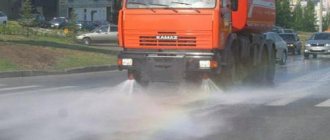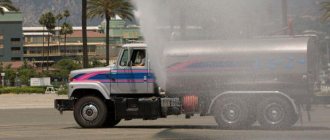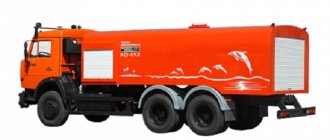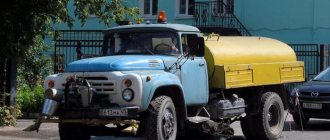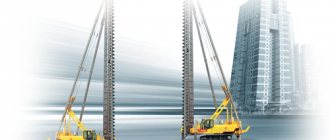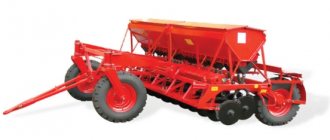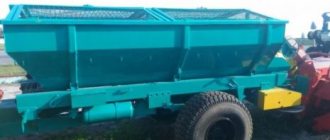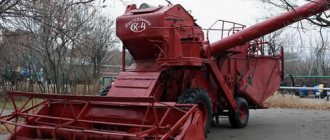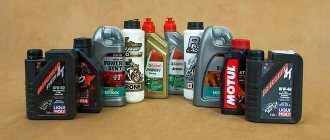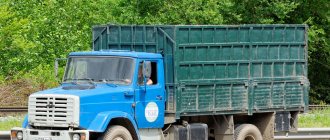BSTU named after. V.G. Shukhova. Department of hoisting and transport and road machines. Coursework in the discipline "Hydraulics and hydraulic pneumatic drive". On the topic: “Modernization of a machine for maintaining roads in the summer. Watering machine." Belgorod 2015.
This work reflects general information about watering machines, two patents modernizing working equipment and one patent for modernizing the hydraulic circuit. The graphic part contains a general view of the PM-130 machine on an A3 sheet and a hydraulic diagram on an A3 sheet. 39 pages of explanatory note containing 39 pages.
Brief technical characteristics of the machine PM-130BTank capacity, l..... 6000 Width of the processed strip, m: when washing. . . . . . . ….. up to 8 when watering ….. . . . . . 15…18 Water consumption, l/m2: when washing……………….. 0.8…1 when watering……………..0.2…0.3 Operating speed, km/h: at washing…….. ………..10 when watering…………….. 20Dimensions with watering equipment, mm: length……… …………..6710 width……… ……….. 2420 height……………………. 2350Greatest height of shifted snow, m. . . . .0.5 Width of the processed strip during snow removal, m: plow…………………. 2.5 with a brush……………………. 2.3Transport speed, km/h. . . . . up to 35 Dimensions with plow and brush equipment, mm: length……………………… 7720 width……………….. 3000 height………………….. 2350Basic chassis. . . . . . .. ZIL-13076
Composition: PM-130 general view, hydraulic diagram, PZ
Software: AutoCAD 2015
Watering and water-washing machines: purpose, classification, characteristics
Watering machines are a type of special equipment that is widely used in public utilities, road repairs, and during construction work. The main design elements of cars of this type are:
- tank or tank;
- centrifugal pump;
- equipment for releasing and distributing the contents of the tank (watering, fire-fighting);
- additional equipment - brushes, plows.
Watering vehicles allow complex cleaning and landscaping work to be carried out more quickly and economically than using manual labor. An additional advantage is the improvement of the microclimate in the airspace in areas of transport highways, and in the warm season - the prevention of overheating and subsequent deformation of the road surface.
Purpose of the watering machine
Watering equipment is used in everyday life in various localities:
- for removing dust, dirt, snow, debris from roads with asphalt or cement concrete surfaces;
- when processing farmland;
- for cleaning sewers;
- for washing, moistening, dust removal of construction sites, building facades;
- when watering green spaces and lawns;
- when extinguishing fires.
The tanks of watering machines are filled with water (in this case they are also used to transport water to various objects) or with reagents - salt, sand, special mixtures, the use of which in winter prevents the road surface from icing.
IRRIGATION MACHINE SERVICES IN ST. PETERSBURG
We have special prices for regular customers. Find out the conditions by calling:
Watering machine: what is it?
Watering machines were first used several decades ago. From ordinary tanks, water was directed by gravity into special spray nozzles. Thus, this technique was a moisturizing one, not a watering one. However, everything changed in the mid-20s of the last century. It was then that watering machines began to be equipped with fire pumps. Thanks to this, water arrows were sent over quite a serious distance.
Why do you need a watering machine?
Modern watering equipment, which is mounted on trucks, is used to clean city roads. In addition, this technique provides the opportunity to significantly reduce the level of dust in the air.
If you are interested in renting a watering machine from RentSpetsTrans, visit the website rentspectrans.ru
In addition to performing the main functions of cleaning roads with cement concrete and asphalt surfaces, such machines are often used for extinguishing fires, watering green spaces, and transporting water.
As practice shows, it is almost impossible to imagine maintaining highways in the summer without watering devices. And here we are talking not only about dirt and dust penetrating onto the roads from the outside. In summer, the road surface becomes the largest dust generator. During the warm season, the condition of roads is directly affected by air temperature. As a result, the road surface begins to “wear out,” which leads to increased dust formation. Naturally, this dust needs to be removed.
We should not forget that in the road infrastructure there are many structures that need to be cleaned: fences, tunnels, posts next to the road, billboards, road signs, etc. Dust regularly settles on these objects, and accordingly, if you do not take care of them , then they will be covered with a huge layer of dirt.
You won't be able to wash it all off by hand. That is why watering machines are made for such purposes.
Classification of watering and watering machines
According to their purpose, road watering machines are divided into 3 basic types:
- specialized watering systems;
- specialized washing facilities;
- combined (universal).
Basic car models differ in the type of working parts - replaceable crevice nozzles (watering or washing, on a cone or hinge mount). When installed, the watering nozzles are turned upward and to the sides, symmetrically with respect to the longitudinal axis of the vehicle base. The washing nozzles are directed down and to the right so that the washed-off dirt flows away from the roadway to the side - to the road tray of the drainage system or for subsequent removal using a street sweeper. The coverage of the surface that can be processed by watering equipment increases noticeably if the car is equipped with not 2, but 3 washing nozzles - two in front (standard option), and one on the side.
The article is devoted to a variety of special vehicles for large cities.
The first Soviet PU-2 sweepers on a GAZ-AA chassis on night duty on the Moscow Garden Ring
The responsibilities of this equipment include regular cleaning, washing and cleaning of urban areas, communications and monuments, maintenance and repair of complex electrical, water supply and sewerage systems, garbage and various waste removal at any time of the year and in any climatic zones.
We dedicate this article to the first, simplest and most inconspicuous automobile workers of large Soviet cities, produced before the collapse of the USSR in 1991 - sweeping and watering and washing machines, commonly known as “sweepers” and “polivalki”. They were based on the chassis of ordinary trucks and in those days performed simple duties: sweeping, watering and washing avenues, streets, squares and parks.
The first Soviet sweeper PU-2 on a GAZ-AA chassis on the Garden Ring in Moscow. 1936
First-born sweepers and waterers
The history of Soviet utility vehicles of the sweeping and watering category began in the mid-1930s with the launch of production of one-and-a-half and three-ton vehicles. The design bureau of the Moscow Improvement Administration (UBM), with an eye on similar German vehicles, was the first to create a fairly advanced PU-2 sweeper vehicle on the chassis of a GAZ-AA truck.
Rare use of the PU-2 sweeper in winter in Leningrad
PU-2 machines with side brush covers spaced apart and extended bumpers
Exact information about the design of the PU-2 has not been preserved, but it is known that it was equipped with a wide rear brush and two side brushes, spaced on both sides of the body and providing a fairly wide cleaning strip, which was “protected” from other people’s cars by a wide bumper. Oversized machines, which usually worked at night, turned out to be too heavy and clumsy. In 1938 they were replaced by the “normal” version of the PU-5.
A simplified PU-5 sweeper with an open arrangement of two side brushes. 1938
In 1945-1946, 20 well-known PU-7 “sweepers” with a characteristic pointed front, capable of removing up to 20 thousand cubic meters of pollution per hour, were assembled on its basis.
The most elegant Soviet sweeper PU-7 with side tray brushes. 1946
The PU-7 diagram shows the main rear brush, auger, inclined conveyor and waste bin
From different sides of the GAZ-AA car there were flat brushes for sweeping debris from trays along the sidewalks and a rear round main brush for cleaning the roadway. The garbage they swept away was thrown onto a screw auger and, using a scraper conveyor, fell into a 400-liter garbage container. To avoid dust in the work area, there was a humidification system with forced water supply to the nozzles. All components operated from the chassis power take-off.
An experimental machine designed by NATI on a ZIS-5 chassis with a V-shaped tank, a main brush in the wheelbase and a right-hand brush with an electric drive. 1940
Since 1936, five-ton YaG-4 trucks with characteristic narrow and elongated bumpers, modified by the Moscow Improvement Administration and the Leningrad Cleaning Trust, were used to carry out summer and winter work. They were equipped with water tanks with a capacity of 4 to 5.5 thousand liters, a centrifugal pump driven by a car transmission, two front and two central spray nozzles for cleaning large areas.
On Red Square there is a PM-4 washing machine on a YAG-4 chassis with an increased tank volume and two nozzles. 1936
On Nevsky Prospect, an MPL-4 watering machine with a reduced-capacity tank and two side nozzles
Yaroslavl "sprinklers" PM-4 clear the Garden Ring after the march of German prisoners on July 17, 1944. On the right is the PU-5 vehicle
On a hot day on Monday, July 17, 1944, Muscovites witnessed an extraordinary spectacle - a procession of hundreds of columns of German prisoners of war stretching for kilometers. 57,640 soldiers and officers - part of the army that planned to capture Moscow in the fall of 1941, nevertheless marched through the city.
“The procession was coming to an end when people standing on the sidewalk suddenly started laughing. Loud exclamations were heard: “That’s right! Carbolic acid! Let's clean it properly, buddy! Cars with a tank were walking along the street and washing the asphalt with elastic jets of water.”
Since 1939, brushes for washing various objects and snow plows were installed on 59 YAG trucks. In the capital alone, by the beginning of 1941, the fleet of street cleaning machines amounted to 632 units.
PM-4 machine in winter configuration with a rotating blade and drive from the driver’s cab
A modernized version of the YAG-6 municipal machine with new washing nozzles. 1940
The rise of the wheeled communal apartment: learning to sweep, wash and water
Already in 1945, work began on previously unknown watering machines with rectangular tanks based on the military-style ZIS-5. In cooperation with other enterprises, the Moscow auto repair shop developed the PM-6 watering vehicle with a tank for three thousand liters of water, a centrally located fire pump and three front nozzles.
Sprinkler PM-6 on a ZIS-5 chassis with three front nozzles and a fire pump. 1945
In Leningrad, MPM-2 “sprinklers” were assembled on two- and three-axle chassis with a front installation of a pumping “organ”, two watering nozzles and four “in reserve”. With the advent of such more advanced technology, work on them was stopped.
Experienced Leningrad watering machines MPM-2
MPM-2 with several types of nozzles and sprinklers?
In 1956, at the Experimental Mechanical Plant of the Department of Improvement of the Moscow City Executive Committee, work began on the creation of the first special sweeper vehicle with operating units driven from the GAZ-51 chassis, designed for operation on improved road surfaces. The PU-8 prototype was planned to be equipped with a second steering wheel and duplicate pedals so that the driver could observe the work process from all sides.
Serial street sweeper PU-20 on a GAZ-51 truck chassis
PU-20 machine for working in cities and on improved road surfaces
The working equipment of the serial “sweeper” PU-20 was housed in a streamlined all-welded body and included two flat side brushes (tray or end) and one rear main brush with a chain drive. The tray brushes supplied the sweep to the longitudinal axis of the car. The rear brush threw it onto an auger, from which the garbage was fed onto a conveyor, which delivered it to a bunker with a volume of a thousand liters. To combat dust, a water pump with a filter and a tank for 1000 liters of water was used, which was supplied under pressure to the under-bumper injectors.
The main quick-release working parts of the “sweeper” PU-20 with a chain drive of the main brush
Humidification system with five spray nozzles located under the bumper
The width of the swept strip of the PU-20 machine was 2.7 meters. At full load its weight reached 6.4 tons. The operating speed ranged from 9.5 to 20 km/h, the maximum transport speed was 40 km/h. Gasoline consumption reached 65.5 liters per 100 kilometers.
In the mid-1950s, tests were carried out in Moscow of a fundamentally new “pneumatic” sweeper PUM-2SD on a GAZ-63 (4?4) chassis, modeled after the German Heuser version. Across its entire width, garbage was sucked into the storage hopper without any moisture by a strong air flow. It was not possible to achieve absolute tightness: the noisy and slow-moving vehicle moved in the clouds of a dust storm.
General view of the PUM-2SD sweeper on the GAZ-63 chassis. 1957
Modernized sweeper PU-53 on a GAZ-53-02 truck chassis. 1966
In the 60s, the PU-53 year-round street sweeper appeared on a reinforced GAZ-53-02 dump truck chassis, identical in general design to its predecessor PU-20. Its new products included a hydraulic control system for working bodies, a modernized screw conveyor and two replaceable waste containers instead of one bunker.
Sweeper PU-53 at the exhibition of municipal vehicles at the Exhibition of Economic Achievements of the USSR. 1967 (photo by the author)
The working width of the PU-53 model and the parameters of the water tank have not changed. The capacity of two replaceable hoppers was 1.4 cubic meters, the maximum speed increased to 85 km/h. It was produced by the Experimental Mechanical Plant of the Moscow City Executive Committee and the Kiev Experimental Plant.
In 1966, production of the first Soviet vacuum sweeping machines VPM-53 based on the GAZ-53A began. Their conventional cylindrical brush moved forward under the driver’s cabin and directed the waste onto tray brushes, which threw it into the suction sleeve of the welded intake nozzle of the pneumatic system. The garbage then fell into a vacuum cyclone bunker created by a high-pressure fan. To unload, the all-metal body was tipped back.
Vacuum sweeper VPM-53 with main and tray brushes and a suction hose. Photo from 1974
The useful capacity of the VPM-53 machine’s bunker was 1.6 cubic meters, the maximum estimated weight was two tons, and the water supply was 760 liters. Operating speeds – from 5 to 16.5 km/h. The total weight of the vehicle is 6.6 tons.
The second, no less extensive, group of watering machines consisted of fairly simple “sprinklers”, created on the basis of serial trucks and designed for watering and washing road surfaces using powerful flat fan-shaped water jets.
The first experimental “sprinkler” in 1955 was the PM-8 machine on a ZIS-150 truck with a closed all-metal body, the work on which was implemented in the design of almost all subsequent vehicles of this category. Two years later, the UBM Design Bureau created a modernized version of the PM-10 for installation on ZIS-150 and ZIL-164 trucks.
Sprinkler PM-10 with front and central nozzles near the theater of the Soviet Army. 1957
Watering machines PM-10 on ZIS-150 chassis with front washing nozzles
The equipment of this machine consisted of a tank with a capacity of six thousand liters, mounted on a spar frame, a single-stage centrifugal pump with filters and a discharge pipeline. From them, water under pressure was supplied to two under-bumper nozzles, but on a number of cars a third nozzle was mounted on the right side under the body. In winter, the P-11 snow removal kit was installed on the PM-10 machine.
Watering machine PM-10 on the chassis of a ZIL-164 truck. 1959
The width of the irrigation strip was 18 meters, in washing mode - seven meters. The dry weight of the PM-10 machine is 5.5 tons, with a full load - 11.5 tons. Operating speeds were within the range of 16-20 km/h.
At the same time, a heavy watering machine PM-9 with a tank for 7.5 thousand liters of water appeared on the chassis of the MAZ-200 truck, and an entire PMP road train with a reserve of seven thousand liters was built in Leningrad.
Leningrad watering road train PMP with a ZIS-120N truck tractor and a tank semi-trailer. 1956
With the advent of ZIL-130 trucks, on their basis, various enterprises assembled PM-130 watering and washing machines with a cardan drive from the power take-off box of a centrifugal single-stage pump mounted on the right side member of the vehicle frame. Unlike the first PM-10 vehicles with decorative body cladding, a welded oval tank of the same capacity with a front water intake hatch, two breakwaters and a device for determining the water level was exposed here for the first time. On both sides there were cases for sleeves and sets of nozzles, and a spotlight was mounted on the roof of the cabin for work at night.
Universal machine PM-130 on a ZIL-130 chassis with front nozzles and a washing brush. 1970s
Depending on the climatic conditions, various brushes driven by the base chassis were mounted under the car frame. Thanks to the hinged mount, the nozzles were installed at any angle, and the driver from the cab could adjust the direction and force of the jet.
Since the second half of the 70s, the most common Soviet “sprinkler” was the PM-130B variant, the modernization of which concerned only minor components.
Modernized watering machine PM-130B on a ZIL-130-76 truck. 1980
For these machines, the width of the treated strip when watering was 15-18 meters, when washing – 7-8. The total weight with water and special equipment reached 11.5 tons, the operating speed was 10-20 km/h. During the entire production period, their own weight of 5.5 tons remained unchanged.
Little-known combined watering machines of several models based on ZIL-130 (KPM-64, KPM-3, KDM-130/130A, etc.) were used in highway maintenance services, equipped with replaceable custom-made equipment and flashing lights, differing in details and a number of parameters and were exported. In different configurations their weight was 5.2-5.8 tons.
Combined watering machine KPM-3 with three powerful nozzles and a summer brush
Communal "watering stations" of the recent past
None of the utility vehicles described here have survived to this day, but they have left new, distinct offspring. Here we will limit ourselves only to special vehicles that were assembled under the general index KO (municipal equipment) and were produced before the collapse of the USSR.
Sweeping machine KO-304 on a GAZ-53A chassis for processing trays and pneumatically feeding waste into a tilting hopper body. 1978
Sweeping machine KO-309 based on GAZ-53-14 with a pneumomechanical pick-up and a flexible hose with a vacuum cleaner tip. 1987
Watering machine KO-002 on a ZIL-431416 chassis with a tank for 6.2 thousand liters of water with hydraulic and sweeping equipment. 1987
A unique multi-purpose road maintenance vehicle ED-244 on a MAZ-5337 truck with a tank capacity of 7.5 thousand liters, a metal body and a blade. 1988
Chernobyl: A huge UMP-1 sprinkler on a BelAZ chassis helped in the decontamination of standard sprinklers and fire trucks washing the facades of houses, streets, trees
Sweeper Pl-3, 1950s, Moscow. Swept about 2500 m within an hour? road surface.
Characteristics
In addition to design features, watering machines differ in the following characteristics:
- tank volume;
- standard width of the working area when watering and washing;
- working width of the brush or plow.
Depending on the model, cars also differ:
- overall dimensions;
- Possibility of configuration: basic equipment - spreading, brush, plow,
- watering (including those intended for cleaning road
- signs of high pressure water jet);
Modern models are designed to use replaceable equipment, which is equipped depending on the season. One car, with a full set of winter-summer equipment, can be used year-round to clean roads with any hard surface. However, it is often necessary to water or clean roads using watering machines in an intensive mode. Thus, in extreme heat or heavy snowfall, harvesting equipment can go out on routes through the territory of populated areas every day and make up to 8-9 trips in one shift.
Watering machine MK-6 6000 l: technical characteristics, device, photo
To maintain city streets in proper condition, especially in the summer, when the dustiness of the roads is very high, the city's municipal services use watering equipment. Nowadays, the most common types of watering equipment are truck chassis with the appropriate equipment installed.
Watering machine MK-6 (6000 l)
There are quite a lot of manufacturers of equipment for municipal services, one of which is the Czech company Kobit. Its products include different versions of this type of equipment, including watering machines.
One of the most common models of watering machines produced by Kobit is the MK-6 model.
Purpose, advantages
This machine is intended for washing and cleaning work on road surfaces in city conditions, as well as for watering flower beds and lawns.
There are enough advantages of this machine. The volume of its water tank is one of the most optimal. Water is pumped into the tank either from an external supply - for this, the tank is equipped with a neck for pumping water, or it is possible to pump water using the pump of the machine itself.
In addition to watering the road surface, MK-6 also cleans the surface with a brush. In this case, the road surface is wetted in front of the brush using washout nozzles. There are also side nozzles that can only be used for watering roads or flower beds.
The disadvantages of this technique include only a relatively narrow list of works that this technique performs - only watering and cleaning. In winter, MK-6 is not in demand.
Photo of watering machine MK-6 6000 l
Device
To install the watering equipment, Kobit chose the chassis of the Mercedes-Benz Atego 815. The load capacity of this two-axle truck is completely suitable.
A tank with a capacity of 6000 liters is installed on the frame of the car. For refueling from a source with external water supply, the tank has a large neck at the top. On the right side of the tank there are outlets for connecting pipelines for pumping water using a machine, as well as for watering flower beds without using nozzles. A hose included with the machine is also attached to these outlets.
Injection and supply of water to nozzles or pipelines is carried out by a powerful water pump with a hydraulic drive. In front of the car, under the bumper, there are side watering nozzles. There is also a front brush attached to the front. All operations with the brush are carried out hydraulically. Flush nozzles are also attached to it.
All operating elements of the MK-6 are controlled using an electronic remote control installed in the cockpit.
Principle of operation
The principle of operation of the MK-6 watering machine for 6000 liters. pretty simple. When filling with water from an external source, the neck of the tank opens, through which it is filled. When refueling is not from an external source, the included hose is connected to the side outlet, the end of which is lowered into a container of water. Next, the pump drive is turned on and it pumps water into the tank.
Watering and cleaning the road surface is done as follows: the driver, using the control panel, lowers the brush and turns on its drive. At the same time, it turns on the water pump, which supplies water through pipelines to the nozzles installed on the brush.
If only watering is required, the driver turns on the side nozzles, which spray water onto the sides of the car.
Specifications
There are not so many technical characteristics provided by the manufacturer for the MK-6 watering machine, and they are shown in the table:
Technical characteristics of the MK-6 watering machine with a volume of 6000 l:
| Characteristics | Unit measurements | Indicators |
| Used car chassis | model | Mercedes-Benz Atego 815 |
| Tank volume | l | 6000 |
| Tank installation | type | stationary, elastic fastenings |
| Water pump drive | type | hydraulic |
| Pump capacity | l/min | 330 |
| Pressure generated by the pump | bar | up to 20 |
| Nozzles used | type | flush, side |
| Optional equipment | — | hose (20 m), brush |
allspectech.com
Watering machines based on KAMAZ, MAZ, ZIL, GAZ - technical characteristics of the models
Watering machine KDM based on KAMAZ - technical characteristics
| 10000 | KAMAZ-65115 | 3/ 12 | 14 | 2,4 | 21,3 | ||
Watering machines KO based on ZIL, KAMAZ - technical characteristics | |||||||
| KO-829AD | order | 6000 | ZIL-497442 | -/8 | 20 | 2,5 | 11 |
| KO-829A | order | 6000 | ZIL-443362 | -/8 | 20 | 2,5 | 11,2 |
| KO-829D | order | 8500 | KAMAZ-53605 | -/8 | 20 | 2,5 | 17,5 |
| KO-829B | order | 13500 | KAMAZ-65115 | -/8 | 20 | 2,5 | 24 |
